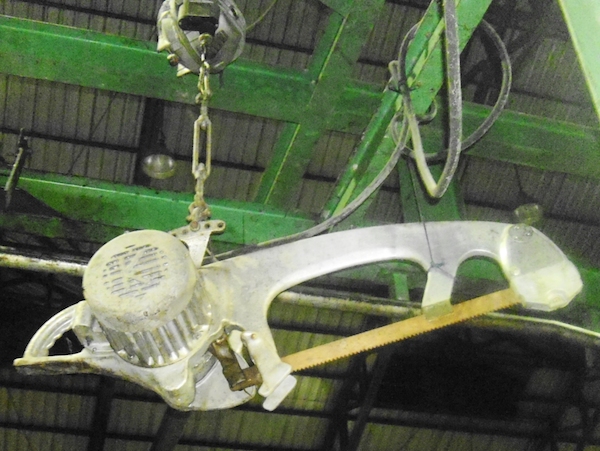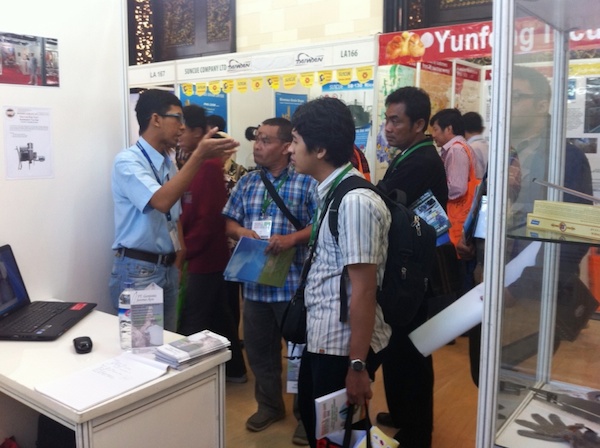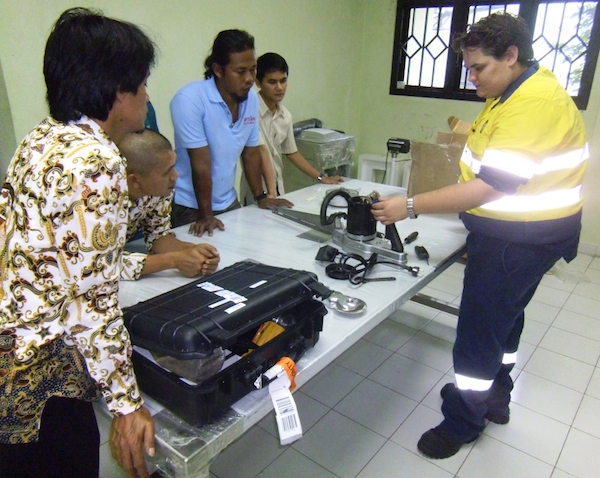The Progression of the Indonesian Abattoir
Host: Lisa Wood/ AGP Indonesia
Written by Lisa Wood – Traceability Officer, AGP.
The average Indonesian Abattoir is not much more than a bare room with a bare floor. Some places may have rails and hooks for hanging the butchered meat. Other places pile it up on the floor. Abattoirs slaughtering imported cattle must have a slaughter box of some type, while those dealing with local cattle do not. Both types process the meat using knives and axes. In contrast, there are a small number of facilities that have processing equipment and I know four facilities that use large chillers. There are more, yet these four I have been in. As an ‘Importer’ my scope is greatly reduced.
Indonesia is currently in the process of massive progressive change in the way abattoirs are built and fitted out. This process started a couple of years ago, yet has been hampered by lack of services on the ground – training for staff and maintenance for equipment.
 A sad and neglected saw – training wasn’t given so the workers didn’t know how to operate it properly. There was no maintenance person trained in how to service it and spare parts were not available. Fortunately that has now changed.
A sad and neglected saw – training wasn’t given so the workers didn’t know how to operate it properly. There was no maintenance person trained in how to service it and spare parts were not available. Fortunately that has now changed.
Indonesia is in the process of bringing its 800 odd registered abattoirs up to ‘NKV’ status. NKV is the abbreviation for ‘Nomor Kontrol Veteriner’, which is the process whereby an abattoir is proven to have fulfilled the requirements of hygiene and sanitation as a basic feasibility of animal based food safety assurance.
They must have buildings, facilities, and infrastructure which meet the technical requirements of hygiene and sanitation. They must have the manpower, the person in charge of technical and technical expertise/skills. They must demonstrate Environment Management, Environmental Control, Good Hygienic Practices, and Good Farming Practices.
The aim of NKV is to protect people and guarantee that foods of animal origin purchased are safe and to improve the competitiveness of Indonesian animal food products in the international market.
What this means is they are moving away from the very basic methods of the past (which is much like station based processing methods for killers) into more modern methods, like we would see in the average Australian abattoir.
As with all change, it takes time and is very costly. It is a process that will take many years and dollars and is not achievable overnight. Let’s face it, Rome wasn’t built in a day.
When I started work here, one of my first questions was “How is Indonesia meant to follow these Australian requests when spare parts and maintenance are not readily available here?” The answer was “Let’s set up another business, you can run it.” Hence PT. Gentala Jasma Ayu was born.
Gentala is our side company that started by selling spare parts for the pneumatic stunners. We also have people trained in the back end servicing of the stunners. The front end of changing bumpers and O-rings is fairly simple – even I can do it. The back end gets a bit more technical and if not done properly can really stuff your machine making it unusable. Recently we have ramped up our sales of abattoir equipment, like cut resistant gloves and different types of saws.
The first year was a bit difficult as I was still learning Indonesian and learning the ropes as to Indonesian regulations, Import Permits, application processes, customs (proper ways to address people), and establishing a network. It was an interesting time and slow going. Then I got my Assistant.
Febrian has been indispensable in getting Gentala really moving forward. He has grown up knowing the proper forms of address. Finer points of important information are not lost due to lack of language knowledge.
My aim is to have a fully trained contingent of Indonesians. Both for Gentala and the capabilities of servicing the wide range of processing equipment we sell, but for our Animal Welfare Officers, the staff on the ground that watch over the Aussie cattle in our supply chain.
Over the past year, it has been wonderful to see the improvement in slaughter skills. Last year I had the fortune of being allowed inside an Australian abattoir and watching the slaughter process. I am proud to say that we have teams here that could match the quality that I watched there. Slaughter is not nice, yet a fast, efficient kill is appreciated.
Allow me to skite a bit – we also have some fantastic Animal Handlers that can control cattle with a flick of their wrist. They are an absolute joy to watch, especially in the midst of a thunder storm.
 Feb at the 8th Indo Livestock Expo & Forum. He was able to spend some quality time with Warren of Kentmaster learning more about the equipment.
Feb at the 8th Indo Livestock Expo & Forum. He was able to spend some quality time with Warren of Kentmaster learning more about the equipment.
Febrian works closely with Kentmaster, our suppliers from Australia. He has also had a steep learning curve, having to learn about the equipment and changes to electricity supply – the differences in voltage between the two countries and what needs to be changed in order for the equipment to be able to operate here.
He has spent time in Australia training and also been inside an Australian abattoir to learn how the equipment is used and what our aim is. This knowledge has been very useful for him with helping Indonesian abattoirs upgrade and be maintained.
We have had Kentmaster staff come over and do a tour of abattoirs that we have sold equipment to; training in how to use the equipment, repairs and training in basic maintenance. Sometimes, something as basic as the blade being put on the wrong way can render a machine useless. Before, there was no customer service, no technical support. It must be disheartening to spend thousands of dollars on a machine that cannot be used due to lack of knowledge. I am pleased to say that we are rectifying that.
 Ryan of Kentmaster, leading Equipment Training. Feb was on hand as translator.
Ryan of Kentmaster, leading Equipment Training. Feb was on hand as translator.
What I find most gratifying is that through Gentala, we are able to reach out to a wider scope of abattoirs, not only those in our AGP supply chain. We are able to reach facilities that process local cattle only. By improving the conditions and knowledge of the workers, my hope is that the flow on effect also improves conditions for the local cattle.
Yes, there are still some facilities in remote villages still practising the traditional methods. One thing to realise is that an Indonesian cow has a very different temperament than an Australian one (more on this in a different blog). The important thing is that things are changing.

